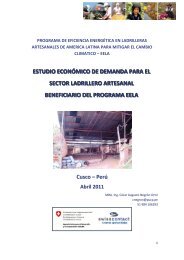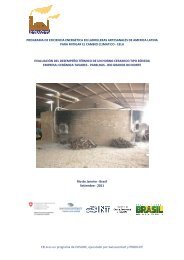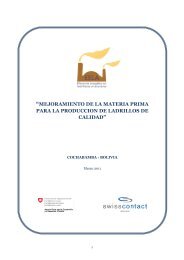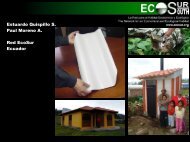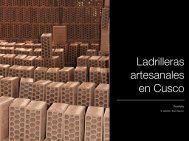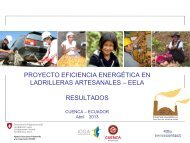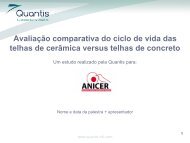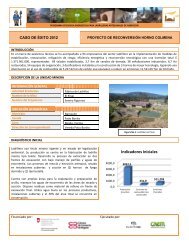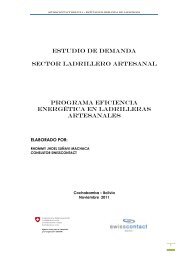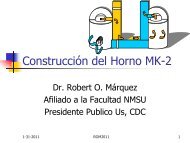A Roadmap for Cleaner Brick Production in India - Red Ladrilleras
A Roadmap for Cleaner Brick Production in India - Red Ladrilleras
A Roadmap for Cleaner Brick Production in India - Red Ladrilleras
- No tags were found...
You also want an ePaper? Increase the reach of your titles
YUMPU automatically turns print PDFs into web optimized ePapers that Google loves.
Adoption of cleaner kiln technologies: The FCBTKs and DDKs should be replaced withzigzag,VSBK or other cleaner kiln technologiesby 2020.Zig-zag kilns appear to be the logical replacement <strong>for</strong> FCBTKs, because of low capital<strong>in</strong>vestment, easy <strong>in</strong>tegration with the exist<strong>in</strong>g production process, and possibility ofretrofitt<strong>in</strong>g FCBTKs <strong>in</strong>to zig-zagfir<strong>in</strong>g. The zig-zag kiln per<strong>for</strong>mance strongly dependson the kiln operation practices;also,zig-zag natural draught kiln appear to per<strong>for</strong>mbetter than zig-zag <strong>for</strong>ced draught kiln. These aspects need further study be<strong>for</strong>ef<strong>in</strong>aliz<strong>in</strong>g recommendations and <strong>for</strong>mulat<strong>in</strong>g a large-scale dissem<strong>in</strong>ation programme<strong>for</strong> zig-zag kilns.VSBK appears to have a limited market, ma<strong>in</strong>ly because of its <strong>in</strong>ability to producegood quality bricks from all types of clays and low productivity under the <strong>India</strong>nconditions. Incorporation of features of Vietnamese VSBKs <strong>in</strong>to <strong>India</strong>n VSBKs mayhelp <strong>in</strong> improv<strong>in</strong>g the VSBK technology package. VSBK dissem<strong>in</strong>ation needs to beproperly targeted.The tunnel kiln technology is capital <strong>in</strong>tensive, and the current technological knowhowand experience is limited <strong>in</strong> <strong>India</strong>. Adoption of tunnel kiln also requires extensivemodifications <strong>in</strong> brick mould<strong>in</strong>g, dry<strong>in</strong>g andmaterial handl<strong>in</strong>g. Widespread adoption oftunnel kiln technology is not <strong>for</strong>eseen <strong>in</strong> immediate future.Promotion of <strong>in</strong>ternal fuel <strong>in</strong> brick mak<strong>in</strong>g by mechaniz<strong>in</strong>g the brick mak<strong>in</strong>g process;Internal fuel addition significantly reduces SPM and BCemissions. Cheaper fuels, such as,coal slurry, coal dust, charcoal dust, and sawdustcan be used as <strong>in</strong>ternal fuels and canhelpreduce fuel cost. Management of <strong>in</strong>ternal fuel addition is extremely difficult <strong>in</strong> the manualmold<strong>in</strong>g process. Semi-mechanization of mould<strong>in</strong>gneeds to be promoted to support use of<strong>in</strong>ternal fuels. Semi-mechanization of the brick mould<strong>in</strong>g process would have other benefits,<strong>in</strong>clud<strong>in</strong>g an ability to use <strong>in</strong>ferior clay resources and wastes, reduction <strong>in</strong> drudgery and betterwork<strong>in</strong>g conditions <strong>for</strong> workers, and potential to produce hollow and per<strong>for</strong>ated bricks.Promotion of mechanized coal stok<strong>in</strong>g systems:High PM and BC emissions <strong>in</strong> FCBTKsoccur dur<strong>in</strong>g the period of fuel feed<strong>in</strong>g. Cont<strong>in</strong>uous feed<strong>in</strong>g of properly sized fuel, us<strong>in</strong>g acoal stoker <strong>in</strong> a FCBTK or a zig-zag kiln, can reduce the emissions significantly.Diversify<strong>in</strong>g products (e.g. hollow and per<strong>for</strong>ated bricks):Hollow and per<strong>for</strong>ated bricksrequire less clay and fuel as well as provide better thermal <strong>in</strong>sulation of walls and henceneeds to be promoted.Promotion of modern renewable energy technologies <strong>in</strong> brick mak<strong>in</strong>g:Apart from the CO 2emissions caused by fir<strong>in</strong>g of coal <strong>in</strong> brick kilns, the current brick mak<strong>in</strong>g practice has a verylow carbon footpr<strong>in</strong>t. Any mechanization of the brick mak<strong>in</strong>g process, as proposed above,would require use of electricity.Captive power generation us<strong>in</strong>g diesel fuel is expensive andhas a high carbon footpr<strong>in</strong>t. Renewable electricity generation options us<strong>in</strong>g biomass gasifiersand solar PV need to be promoted. Semi-mechanization of the brick mould<strong>in</strong>g process alsorequires artificial dry<strong>in</strong>g, which may <strong>in</strong>crease the coal consumption <strong>in</strong> brick mak<strong>in</strong>g. There is20



